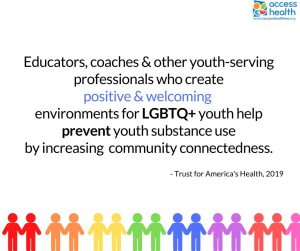Happy Pride Month from Access Health!
In the spirit of Pride Month, we are highlighting actions that parents, healthcare providers, educators and the community can take to help prevent substance use within the LGBTQ+ population.
Research tells us that LGBTQ+ youth face a greater number of risk factors such as social stigma, isolation, discrimination and violence that increase the chances of using harmful substances and/or developing a substance use disorder in adulthood.[1],[2]
A lack of data focusing on the LGBTQ+ youth population has proven to be a barrier for creating effective programs like prevention initiatives, as sexual orientation questions have historically been left out of national/state surveys as well as within healthcare settings.
The 2019 Maine Integrated Health Youth Survey data shows concerning differences in the rates of substance use for LGBTQ+ high school students compared to heterosexual students. Known risk factors for substance use like bullying, home violence and unwanted sexual experiences are also more likely within the LGBTQ+ student population.[3]

Actions to Help Prevent Substance Use for LGBTQ+ Youth
Developing positive relationships with caring adults is an important protective factor for all youth. How parents engage with their child or teen can have a strong impact on their current and future mental and physical health.[4] Parents and other caring adults can create a supportive environment where LGBTQ+ youth feel comfortable talking openly about their identity, challenges they may be experiencing related to their sexual orientation and substance use.[5]
Healthcare providers can educate themselves and their practice to understand the stresses and risk-factors LGBTQ+ experience, while building cultural competency skills. Substance use treatment and prevention programs can establish non‐discrimination policies to enhance inclusiveness to reach this more vulnerable population.
School systems can design evidence-based policies, procedures and activities to promote a healthy environment for LGBTQ+ youth, such as anti-bullying policies, gay-straight alliance programs and other supportive resources.
Communities can create safe spaces for LGBTQ+ youth where they can socialize, develop and feel a sense of community connectedness.[6] Influential adults can help guide youth toward opportunities to join local organizations where they can interact with other LGBTQ+ youth as well as offering to connect teens with a broader network of support.[7]
Connect with a LGBTQ+ organization
Find Resources for youth, parents, healthcare providers and educators

